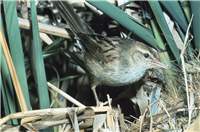Family
Sylviidae
Genus
Megalurus
Species
gramineus
Threats/Control Methods - Regional
The Commonwealth Government is currently working to control the feral pigs across the region through a specialised abatement plan, hoping to decrease the risks to native species and their habitats, such as the Little Grassbird. Prolonged droughts will also impact upon this water dwelling bird.
Threats/Control Methods - Local
Water bodies in urban areas are less resilient against periods of droughts or extreme weather events, causing a build-up of toxins and dangerous algae levels, which may impact the health of this species. For example, Jerrabomberra Creek Catchment is currently degraded from grazing, polluted stormwater from the Hume industrial estate, road surface runoff and rural residential developments.
Local/Urban Actions
Joining in a revegetation project around waterways with a local Landcare group can improve the vegetation available for this species. Urban water bodies will maintain better health if storm water is kept unpolluted. At home, it is important avoid chemicals, pet faeces or garden waste going down the stormwater drain. Keep gutters clean and call the Canberra Connect helpline on (02) 6207 9777 for specific chemical waste disposal information.
Common Names
Little Grassbird, Little Marshbird, Striated Grassbird
Distinguishing Features
This is a small 13-15cm bird with a streaked appearance of olive- brown, cream, grey, orange and black. The top of the head and rump are orange-brown, the wings are grey-brown with black streaks and the tail is dark brown. Underparts are light cream with fine black streaks. The eye is brown with a cream eyebrow and the bill is straight and pointed. This bird is very secretive and is most commonly distinguished by its piping call.
Survey Techniques
Call and visual identification.
Species Call
Three mournful piped notes 'pe-peeee-peeeee' or an alarmed 'chu-chu-chu' rattle.
Similar Species
The Tawny Grassbird (Megalurus timoriensis) is larger and lacks the streaking across its head and underparts. The Clamorous Reed-Warbler (Acrocephalus stentoreus ) shares the same habitat and behaviour.
Distribution
This species is mostly found in the southeast region of Australia from southern QLD, down to TAS and across to Adelaide in SA. They are also found in the southwest of WA. They may travel out of these regions in rare numbers. Some inhabit New Guinea.
Country of Origin
Australia
Conservation (Pet/Pest) Status - Regional
This uncommon species is only seen around Lake Burley Griffin or at the Jerrabomberra Wetlands.
Conservation (Pet/Pest) Status - National
Secure, not listed under the EPBC Act 1999.
LSCCES Population
One bird was sighted on the ANU campus.
Associated vegetation community
This species inhabits the vegetation around wetlands, swamps and mangroves, in particular lignum, cumbungi (Typha) and cane grass.
Limiting Resources
Little Grassbirds require very dence, wet vegetation for feeding and nesting.
Breeding
Most breeding activities take place from August to January. The nest is a very deep cup of dried grasses and water plants, placed within the thick reeds and clumps of edge vegetation, 0.5 to 1.5 metres off the ground. Nests are lined with feathers, usually from Purple Swamphen (Porphyrio porphyrio ), placed vertically to stick out the top of the nest and provide a sheltering arch. The 2-5 eggs are white or pink-tinged, speckled with purple and red. Each egg requires about 9 days of incubation.
Behaviour
This very secretive species can be seen briefly, alone or in pairs, fluttering through thick reeds with its tail fanned. It is more often recognised by its piping call, although it is silent and difficult to find over the winter months.
Functional Group
Food Species
The Little Grassbird hops swiftly through vegetation, picking up insects, spiders and small shelled creatures.
Predators
This species in prone to attacks from any predator that can squeeze or force through the thick rushes into their nesting territory. This may include European Red Foxes (Vulpes vulpes), the Australian Raven (Corvus coronoides ), Black Rats (Rattus Rattus) and Feral Pigs (Sus Scrofa).
Interesting Fact
Little Grassbirds are considered to display cryptic behaviour, making them difficult to study and understand.
References - (reader suitability of references, P=Primary teachers, S=Secondary students, T=Tertiary students and researchers)
Books:Morcombe, M. 2000. Field Guide to Australian Birds. Steve Parish Publishing. Archerfield. Australia P, S, T
Schodde, R. and Tideman, S. (eds) 1990. Reader's Digest Complete Book of Australian Birds (2nd Edition). Reader's Digest Services Pty Ltd. Sydney. P, S, T
Taylor, M. and Day, N. 1993. Field Guide to the Birds of the ACT. National Park Association of the ACT Inc. Canberra. P, S, T
Internet: Birds in Backyards. 2006. [online]. Available at:http://www.birdsinbackyards.net P, S, T
Online Publications:ACT Government. 2006. Information Sheet: Stormwater Pollution from Residential Areas. Environment ACT. [online]. Available at: http://www.environment.act.gov.au/__data/assets/pdf_file/13168/Stormwater_Pollution_from_Residential_Areas.pdf P, S, T
Department of Environment and Heritage. 2004. The feral pig (Sus Scrofa). The Australian Government. Canberra. [online]. Available at: http://www.environment.gov.au/biodiversity/invasive/publications/pig/index.htmlP, S, T
McIntosh, R et al. 2003. Breeding ecology and bias in offspring sex ratio in little grassbirds (Megalurus gramineus). Australian Journal of Zoology. 51:505-514 CSIRO Publishing. [online]. Available at: http://www.publish.csiro.au/?act=view_file&file_id=ZO03002.pdf T
Nix, H. and Cunningham, R. 2006. Birds of the Lower Sullivans Creek Catchment, Canberra ACT. Prepared for the Life in the Suburbs project using data from the Lower Sullivans Creek Catchment Ecological Survey (LSCCES). Australian National University. Canberra. [online]. Available at: http://www.lifeinthesuburbs.com.au/category.php?id=65 S, T
Queanbeyan City Council. 2004. Study on the Current State of Jerrabomberra Creek . Maunsell Australia Pty Ltd. Canberra. [online]. Available at: http://www.qcc.nsw.gov.au/Documents/YRJTKVCEDKP.pdf S, T

 Top
Top Top
Top